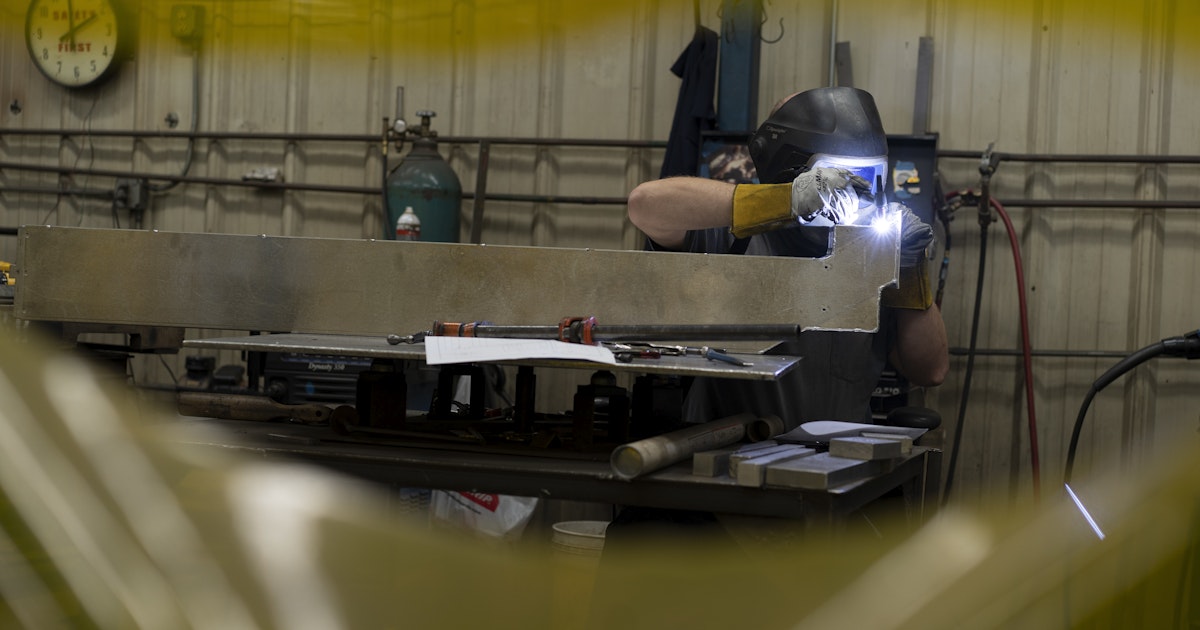Understanding America’s Labor Shortage

We hear every day from our member companies—of every size and industry, across nearly every state—that they’re facing unprecedented challenges trying to find enough workers to fill open jobs. Right now, the latest data shows that we have 8.8 million job openings in the U.S., but only 6.4 million unemployed workers.
We have a lot of jobs but not enough workers to fill them. If every unemployed person in the country found a job, we would still have nearly 2.4 million open jobs.
The U.S. Chamber is capturing the trends on job openings, labor force participation, quit rates, and more, for a quick understanding of the state of the workforce in our America Works Data Center. Read on for an analysis of the state of the workforce on the national level.
Why are we in a worker shortage?
At the height of the pandemic, more than 120,000 businesses temporarily closed, and more than 30 million U.S. workers were unemployed. Since then, job openings have steadily increased while unemployment has slowly declined.
In 2023, employers ended up adding 3.1 million jobs. A strong jobs market is good news, but many of those job openings are going unfilled because the U.S. does not have enough workers to fill them. Even though we have more Americans participating in the workforce today than before the pandemic, the overall share of the population participating in the labor force has dropped. If our labor force participation rate today was the same as it was in February of 2020, we would have two million more Americans in our workforce to help fill those open jobs.
Stand Up for Free Enterprise
Join us and become a part of our movement to save the system that will secure our collective future.
Your voice is essential, and your participation is critical.
In fact, the decline of Americans’ labor force participation is nothing new—fewer and fewer Americans have been participating in the labor force for decades, resulting in a smaller workforce that is expected to continue shrinking for years to come.
Understanding the Gap
Right now, the labor force participation rate is 62.7%, down from 63.3% in February 2020 and 67.2% in January 2001. There’s not just one reason that workers are sitting out, but several factors have come together to cause the ongoing shortage. The factors detailed in the next section have all contributed to a labor shortage.

Additionally, in May 2022, the U.S. Chamber surveyed unemployed workers who lost their jobs during the pandemic to gain more insight into what is keeping them from returning to work. Here are a few of the key findings.
- Two-thirds (66%) of Americans who lost their full-time job during the pandemic say they are only somewhat active or not very active at all in searching for a new job.
- About half (49%) are not willing to take jobs that do not offer the opportunity for remote work.
- More than a quarter (26%) say it will never again be essential for them to return to work.
- Nearly one in five have altered their livelihood, 17% have retired, 19% have transitioned to homemaker, and 14% are now working part-time.
- Almost a quarter (24%) say government aid packages during the pandemic have incentivized them to not actively look for work.
- Younger respondents, aged 25-34, are prioritizing personal growth over searching for a job right now; 36% say they’re more focused on acquiring new skills, education, or training before re-entering the job market.
Factors Contributing to the Labor Shortage
Early retirements and an aging workforce
As of October 2021, the pandemic drove more than 3 million adults into early retirement. In all, the number of adults 55 and older being detached from the labor force due to retirement grew from 48.1% in Q3 of 2019 to 50.3% in Q3 2021.
Additionally, the share of older individuals within the U.S. population is steadily increasing, and it’s likely this trend will continue. This shift is partly attributable to the fact that younger generations are having fewer children compared to their predecessors, resulting in a progressively older, and diminishing population.
Net International Migration to the U.S. is at its lowest level in decades
U.S. Census Bureau data shows that net international migration to the U.S. only contributed to a 247,000-person increase in the U.S. population between 2020 and 2021. Compared to the prior decade’s high of a 1,049,000 increase in our population between 2015 and 2016 due to immigration, the impact that immigration has had on U.S. population growth dropped by 76%.
Lack of access to childcare
Even before the pandemic, a lack of access to high-quality, affordable childcare was an issue. Research from the U.S. Chamber of Commerce Foundation found that due to breakdowns in the childcare system, the states surveyed (Alaska, Arkansas, Arizona, Missouri, and Texas) missed an estimated average of $2.7 billion annually for their economies.
A report from the U.S. Chamber of Commerce Foundation and The Education Trust shows that the pandemic created a vicious cycle for the industry; to return to work, workers need reliable childcare, but providers are facing immense challenges themselves. The pandemic forced many childcare providers to close or scale down: between February and April 2020, the industry lost 370,600 jobs — 95% of which were held by women. Unfortunately, the recovery has not been swift; as late as September 2021, childcare industry employment remained 10 percent lower than pre-pandemic levels.
Additionally, women are participating in the labor force at the lowest rates since entering the labor force in meaningful numbers in the 1970s. In the spring of 2020, 3.5 million mothers left their jobs, driving the labor force participation rate for working moms from around 70% to 55%.
Even though there are more women working now than in February 2020, women’s labor force participation rate has not yet fully recovered to its pre-pandemic rate or to when it was at an all-time high of 60.2% in early 2001.
In the Chamber’s survey of unemployed workers who lost their jobs during the pandemic, 27% indicated that the need to be home and care for children or other family members has made the return to work difficult or impossible.
New business starts
In the spirit of entrepreneurship, some employees either left work or stayed unemployed to open their own businesses. In 2023, 5.5 million new businesses were started, continuing a trend of record-high numbers of new business applications being filed over the last several years. There have already been 884,981 new business applications filed in 2024.
Workers of all ages, but primarily younger generations, have also tapped into a new source of income in large numbers—digital commerce. In 2020, 2 million individuals made six figures or more on social media. The cultural shift spurred by the digital age is spreading into the labor market, introducing new challenges to attracting employees that employers must now navigate.
An increase in savings
Enhanced unemployment benefits, stimulus checks, and not being able to go out and spend money during the COVID-19 pandemic all contributed to Americans collectively adding $4 trillion to their savings accounts since early 2020. The extra few hundred dollars a week from enhanced unemployment benefits (which ended in Sept. 2021), specifically, led to 68% of claimants earning more on unemployment than they did while working.
In the Chamber’s survey, 23% of women cited others in the family making enough money and said that working full-time is not as critical as the reason they have not re-entered the workforce. Higher income and savings bolstered people’s economic stability—allowing them to continue sitting out of the labor force. However, high inflation is driving down savings accounts, necessitating the need for many to return to the workforce.
The Great Reshuffle
The Great Resignation worked its way into our vocabulary as the shift of our labor force started to become apparent—and the hashtag #quittok even went viral as social media users posted about quitting their jobs in search of more free time or better opportunities.
However, the story is more complex than individuals leaving their job. In fact, a more appropriate moniker for the high quit rates over the past few years is the “Great Reshuffle.” More than 44 million Americans quit their jobs in 2023, and 3.4 million quit in January 2024 alone. However, the hiring rate has outpaced the quit rate since November 2020. This means Americans are seeking – and finding – better opportunities with new employers and in new occupations and industries.

These reasons above help illuminate the current labor shortage landscape, but the examples are non-exhaustive.
Understanding why workers are missing from unfilled jobs is only half of the equation. The next step in addressing the labor shortage is to implement solutions to attract and retain new workers is underway.
Learn about how the U.S. Chamber is driving solutions through the America Works Initiative. For more information on the America Works Initiative, contact Stephanie Ferguson at sferguson@uschamber.com.
About the authors

Stephanie Ferguson
Stephanie Ferguson is the Director of Global Employment Policy & Special Initiatives. Her work on the labor shortage has been cited in the Wall Street Journal, Washington Post, and Associated Press.
Related
U.S. economy adds jobs as federal layoffs and rising unemployment…
Julia Coronado: I think it's too early to say that the U.S. is heading to a recession. Certainly, we have seen the U.S. just continue t
The job listing site highlighting H-1B positions so Americans can…
A mysterious new job listings website recently went live, solely showing roles companies want to offer to their H-1B holders seeking Green Cards in an attempt t
Tepid February Jobs Report Boosts Odds of a June Fed…
Federal Reserve Board Chairman Jerome Powell speaks during a news conference. Photo by Chip ... [+] Somodevilla/Getty Images.Getty Images The February jobs repo
French university offers jobs to American scientists afraid of government…
As the current federal government in the U.S. has been freezing or cutting funding for several research grants, a French university has stepped in with an offer













